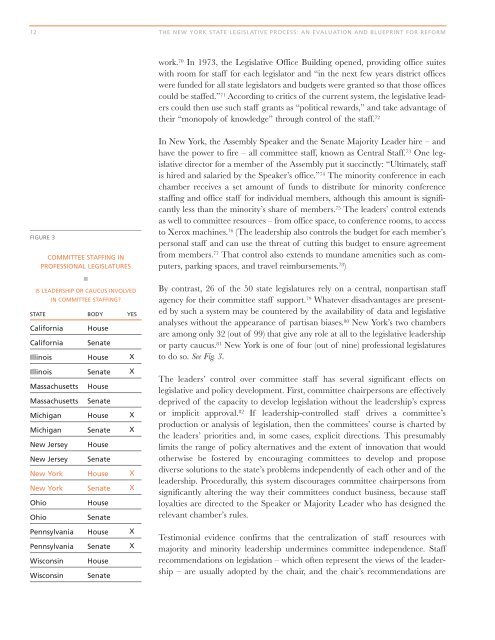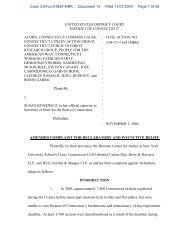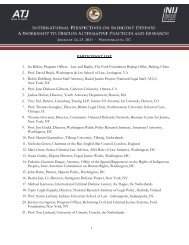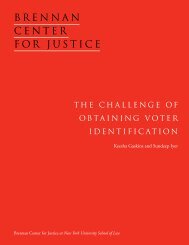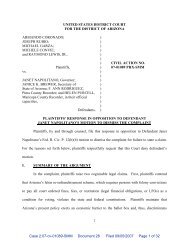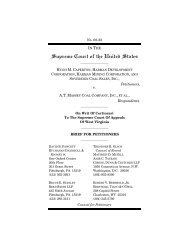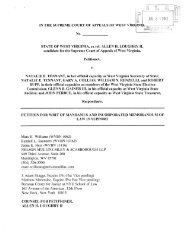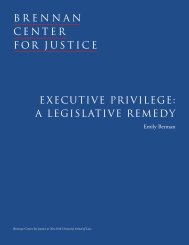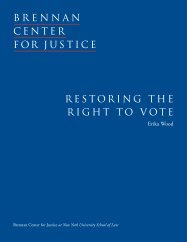THE NEW YORK STATE LEGISLATIVE PROCESS: AN ...
THE NEW YORK STATE LEGISLATIVE PROCESS: AN ...
THE NEW YORK STATE LEGISLATIVE PROCESS: AN ...
You also want an ePaper? Increase the reach of your titles
YUMPU automatically turns print PDFs into web optimized ePapers that Google loves.
12 <strong>THE</strong> <strong>NEW</strong> <strong>YORK</strong> <strong>STATE</strong> <strong>LEGISLATIVE</strong> <strong>PROCESS</strong>: <strong>AN</strong> EVALUATION <strong>AN</strong>D BLUEPRINT FOR REFORM<br />
FIGURE 3<br />
COMMITTEE STAFFING IN<br />
PROFESSIONAL LEGISLATURES<br />
■<br />
IS LEADERSHIP OR CAUCUS INVOLVED<br />
IN COMMITTEE STAFFING?<br />
<strong>STATE</strong> BODY YES<br />
California House<br />
California Senate<br />
Illinois House X<br />
Illinois Senate X<br />
Massachusetts House<br />
Massachusetts Senate<br />
Michigan House X<br />
Michigan Senate X<br />
New Jersey House<br />
New Jersey Senate<br />
New York House X<br />
New York Senate X<br />
Ohio House<br />
Ohio Senate<br />
Pennsylvania House X<br />
Pennsylvania Senate X<br />
Wisconsin House<br />
Wisconsin Senate<br />
work. 70 In 1973, the Legislative Office Building opened, providing office suites<br />
with room for staff for each legislator and “in the next few years district offices<br />
were funded for all state legislators and budgets were granted so that those offices<br />
could be staffed.” 71 According to critics of the current system, the legislative leaders<br />
could then use such staff grants as “political rewards,” and take advantage of<br />
their “monopoly of knowledge” through control of the staff. 72<br />
In New York, the Assembly Speaker and the Senate Majority Leader hire – and<br />
have the power to fire – all committee staff, known as Central Staff. 73 One legislative<br />
director for a member of the Assembly put it succinctly: “Ultimately, staff<br />
is hired and salaried by the Speaker’s office.” 74 The minority conference in each<br />
chamber receives a set amount of funds to distribute for minority conference<br />
staffing and office staff for individual members, although this amount is significantly<br />
less than the minority’s share of members. 75 The leaders’ control extends<br />
as well to committee resources – from office space, to conference rooms, to access<br />
to Xerox machines. 76 (The leadership also controls the budget for each member’s<br />
personal staff and can use the threat of cutting this budget to ensure agreement<br />
from members. 77 That control also extends to mundane amenities such as computers,<br />
parking spaces, and travel reimbursements. 78 )<br />
By contrast, 26 of the 50 state legislatures rely on a central, nonpartisan staff<br />
agency for their committee staff support. 79 Whatever disadvantages are presented<br />
by such a system may be countered by the availability of data and legislative<br />
analyses without the appearance of partisan biases. 80 New York’s two chambers<br />
are among only 32 (out of 99) that give any role at all to the legislative leadership<br />
or party caucus. 81 New York is one of four (out of nine) professional legislatures<br />
to do so. See Fig. 3.<br />
The leaders’ control over committee staff has several significant effects on<br />
legislative and policy development. First, committee chairpersons are effectively<br />
deprived of the capacity to develop legislation without the leadership’s express<br />
or implicit approval. 82 If leadership-controlled staff drives a committee’s<br />
production or analysis of legislation, then the committees’ course is charted by<br />
the leaders’ priorities and, in some cases, explicit directions. This presumably<br />
limits the range of policy alternatives and the extent of innovation that would<br />
otherwise be fostered by encouraging committees to develop and propose<br />
diverse solutions to the state’s problems independently of each other and of the<br />
leadership. Procedurally, this system discourages committee chairpersons from<br />
significantly altering the way their committees conduct business, because staff<br />
loyalties are directed to the Speaker or Majority Leader who has designed the<br />
relevant chamber’s rules.<br />
Testimonial evidence confirms that the centralization of staff resources with<br />
majority and minority leadership undermines committee independence. Staff<br />
recommendations on legislation – which often represent the views of the leadership<br />
– are usually adopted by the chair, and the chair’s recommendations are


